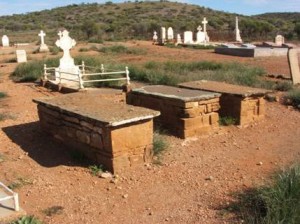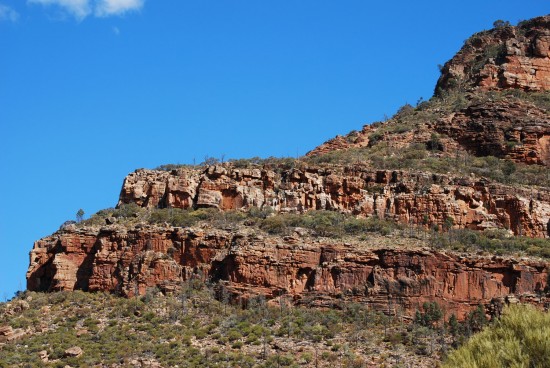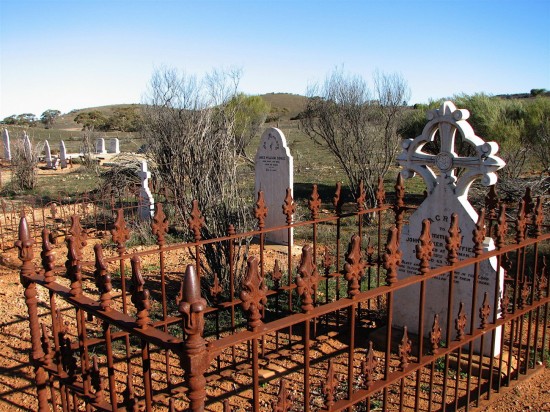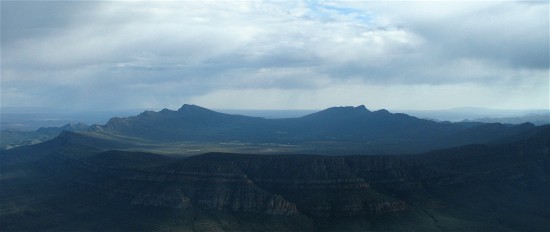The jutting hills and red sandstone outcrops of the North Flinders Ranges form an imposing backdrop to the small historic town of Blinman nestled in their folds, ranks of silent sentinels which witnessed the tenuous hold South Australia’s early pioneers had on this harshly beautiful land.
A walk around the cemetery just outside the town, with a light spring breeze stirring the red dust between the headstones, is a moving experience offering insight into the boom and bust times of the Blinman copper mine and the struggle by immigrant families to tame the environment.
 But they never really did, and the inscriptions on the headstones bear silent witness to the lives and loves lost, some barely started, forever sleeping in the rocky cradle of the Flinders.
But they never really did, and the inscriptions on the headstones bear silent witness to the lives and loves lost, some barely started, forever sleeping in the rocky cradle of the Flinders.
The earliest legible headstones in the cemetery south of the town date back to 1867, but others as early as 1864 can be found near the Blinman Mine on the northern outskirts, put there before the cemetery was established.
There is the grave of Jane Trevorrow, the daughter of Captain J. O. Anthony who came out from Cornwall, England, to manage the mine. She died in April 1864, aged 30.
Nearby are the graves of Annie Anthony, wife of Thomas Anthony (believed to be the brother of Captain Anthony), and their two baby sons. William died aged six months in May 1865; Annie, 24, died in childbirth or soon after in March 1866, and her baby boy Thomas died two months later.
Over in the cemetery, the brief life stories etched in stone are similar. Under a single headstone lies Louise Fels who died in August 1874, aged 29, and her unnamed newborn twin sons.
Another headstone, erected by the townspeople, marks the grave of William Golborne, who was killed in a powder explosion in August 1873, aged 47. His headstone reads: “In the midst of life we are in death”.
Just near the cemetery gate is an impressive headstone, erected by the Royal Geographical Society of Australasia, in admiration of the pluck, endurance and loyalty of English explorer William Darton Kekwick. Kekwick died at nearby Nuccalena in 1872 at the age of 49 while travelling north with William Gosse’s Central and Western Exploring Expedition.
It was an untimely end for the man who had been John McDouall Stuart’s second in command from 1859-1863, had been involved in three attempts from Adelaide to the Indian Ocean to cross the continent south to north, and was with Stuart when the British flag was placed in the centre of Australia on April 22, 1860, and on the shores of the Indian Ocean on July 25, 1862.
But the cemetery is only one aspect of the town, much of which was built with the sweat and toil of immigrant miners. The Blinman Mine, 60km north of Wilpena Pound, was named after shepherd Robert Blinman who discovered copper there in 1859.
Mining began in 1862 and smelting works were built in 1863 to produce copper ingots. The mine produced 10,000 tonnes of copper over the next 45 years worth about $30 million, most of which was won from the ground in two intensive mining periods from 1862-75 and 1903-07.
Photo Credits
Outback Cemetery by kabl1992 on flickr – some rights reserved
Blinman Cemetery – Source – ancestry.com
Bluff – Northern Flinders Ranges – Wikipedia Creative Commons
Postcard View of Wilpena Pound by kabl1992 on flickr – some rights reserved
Blinman – Northern Flinders Wikipedia Public Domain






[…] 700km north of Adelaide, is an ideal base from which to explore the North Flinders Ranges. Within an hours’ drive is Brachina Gorge,a geological trail signposted along the 20km track […]